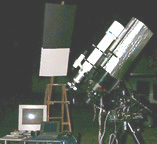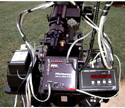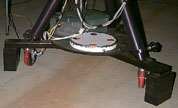



When my C11 arrived, it would not hold collimation. I would collimate East. When I moved the scope west, it would be out of collimation. When I asked Company 7 about this, the said "It was fine when it left here. Do not mess with it." I sent the telescope to Celestron. Celestron reported that the primary mirror was loose. They fixed it and returned in after six weeks. Was the primary loose when the telescope left Company 7? It is hard to tell. I do know that not all the staples on the inner OTA cardboard box had been broken open. Some had been and some had not been. I had to break them all open to get the OTA out of the box.
The C11 seems to have fair optics. It has a lot of light grasp and does an excellent job at CCD imaging. It will show me the six star of the Trapezium with out any effort. The Cassini Division and Crape rings of Saturn are clearly visible even on nights with below average seeing. The OTA has had flock paper installed inside it to cut down on internal reflections. This job was done by Cory Suddarth of Orion.
After nearly a year of serving me well, the primary mirror came lose again. This time, I decided to try to fix it myself. With great caution, I disassembled the OTA and examined the mirror mounting. I found that the monstrous glass mirror sits on cylindrical mirror mount. The space between the mirror mount and the mirror is filled with RTV. This RTV can come loose and cause the mirror to shift just a bit as it is moved around the sky. It appeared that re-mounting the mirror would required special tooling. Rather than attempt this, I choose simple, but radical, hack repair. The focus arm reaches out from the mirror mount across the mirror. I filled the space between this arm and mirror with gobs and gobs of RTV. The idea being to give the mirror more support. It took almost a week for this mess of RTV to set. I am happy to report the results are positive. The OTA stays in collimation and no bad side effects have been observed.
Takahashi telescopes are not only of excellent optical quality but they also have superb mechanics. The focuser in smooth as silk, robust, accurate and repeatable. There is a full line of accessories available for this scope including large and small format camera adapters, focal reducers, barlow, eyepiece projection hardware and that wonderful camera rotator.
The Takahashi or the Traveler. Which is a better telescope? It is hard to say. They are both show superb quality. They are also different. The Traveler is f/5.8. The Takahashi is f/8. The Traveler folds down to 19" inches. The Takahashi is nearly a yard long. They serve different purposes. The Traveler travels. The Takahashi is right at home on top of the C11. I would not want to be without either of them.